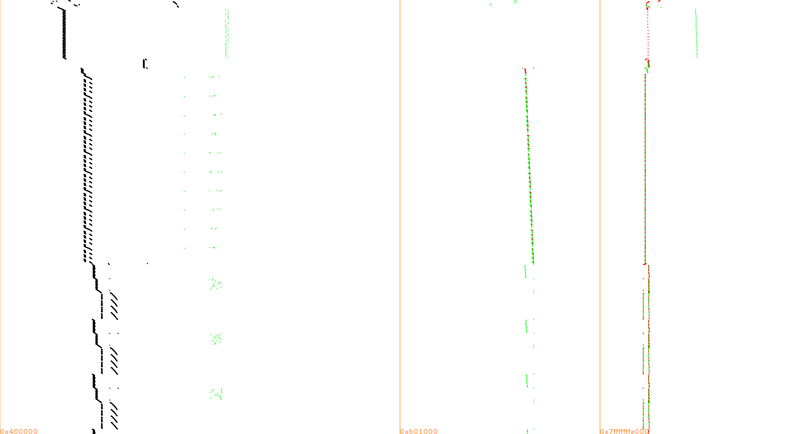Difference between revisions of "MoVfuscator Writeup"
m (→Open samples) |
m (→Conclusions) |
||
| Line 104: | Line 104: | ||
Lessons: |
Lessons: |
||
<br>'''Yes, M/o/Vfuscator2 sounds very appealing to harden your processing.''' |
<br>'''Yes, M/o/Vfuscator2 sounds very appealing to harden your processing.''' |
||
| − | <br>'''No, don't |
+ | <br>'''No, don't count on it to harden any cryptographic processing!''' |
Revision as of 13:38, 10 August 2015
Intro
Three days ago Chris Domas announced the release of M/o/Vfuscator2, a beautiful single instruction C compiler leveraging the paper "mov is Turing-complete" (pdf), by Stephen Dolan.
That's it, once compiled, your program is made only of MOV instructions.
See the REcon 2015 slides (pdf) for more insight.
The code is available here: https://github.com/xoreaxeaxeax/movfuscator and by default check.sh will apply it on https://github.com/kokke/tiny-AES128-C , a small portable AES128 implementation.
So, is it safe to protect your AES crypto with M/o/Vfuscator2?
Coincidentally we published a new attack against white-boxes a few days ago: Differential Computation Analysis: Hiding your White-Box Designs is Not Enough.
M/o/Vfuscator2 doesn't transform your AES into a traditional white-box based on look-up tables but we should admit it's quite intimidating for a reverser.
Visualization
For example, here is a trace of the initial AES, up to the first three rounds:

Same convention as in our paper: memory range on the X-axis, time counting from top to bottom on the Y-axis, instructions in black, mem reads in green, mem writes in red.
And here once it's compiled with M/o/Vfuscator2

Ouch! That's why I limited the trace to the first 3 rounds, it's so huge that I've disk space and RAM issues to display more...
The black square is simply the main MOV loop repeating all long, so if there is information, it should be in the memory accesses.
Challenge
The initial tiny-AES128-C example encrypts a fixed plaintext with a fixed key but let's make a more realistic challenge where one can provide arbitrary plaintexts.
#include <stdio.h>
#include <string.h>
#include <stdint.h>
#define CBC 0
#define ECB 1
#include "aes.h"
static const uint8_t *CHRHEX = (uint8_t *)
"\xFF\xFF\xFF\xFF\xFF\xFF\xFF\xFF\xFF\xFF\xFF\xFF\xFF\xFF\xFF\xFF" \
"\xFF\xFF\xFF\xFF\xFF\xFF\xFF\xFF\xFF\xFF\xFF\xFF\xFF\xFF\xFF\xFF" \
"\xFF\xFF\xFF\xFF\xFF\xFF\xFF\xFF\xFF\xFF\xFF\xFF\xFF\xFF\xFF\xFF" \
"\x00\x01\x02\x03\x04\x05\x06\x07\x08\x09\xFF\xFF\xFF\xFF\xFF\xFF" \
"\xFF\x0A\x0B\x0C\x0D\x0E\x0F\xFF\xFF\xFF\xFF\xFF\xFF\xFF\xFF\xFF" \
"\xFF\xFF\xFF\xFF\xFF\xFF\xFF\xFF\xFF\xFF\xFF\xFF\xFF\xFF\xFF\xFF" \
"\xFF\x0A\x0B\x0C\x0D\x0E\x0F\xFF\xFF\xFF\xFF\xFF\xFF\xFF\xFF\xFF" \
"\xFF\xFF\xFF\xFF\xFF\xFF\xFF\xFF\xFF\xFF\xFF\xFF\xFF\xFF\xFF\xFF" \
"\xFF\xFF\xFF\xFF\xFF\xFF\xFF\xFF\xFF\xFF\xFF\xFF\xFF\xFF\xFF\xFF" \
"\xFF\xFF\xFF\xFF\xFF\xFF\xFF\xFF\xFF\xFF\xFF\xFF\xFF\xFF\xFF\xFF" \
"\xFF\xFF\xFF\xFF\xFF\xFF\xFF\xFF\xFF\xFF\xFF\xFF\xFF\xFF\xFF\xFF" \
"\xFF\xFF\xFF\xFF\xFF\xFF\xFF\xFF\xFF\xFF\xFF\xFF\xFF\xFF\xFF\xFF" \
"\xFF\xFF\xFF\xFF\xFF\xFF\xFF\xFF\xFF\xFF\xFF\xFF\xFF\xFF\xFF\xFF" \
"\xFF\xFF\xFF\xFF\xFF\xFF\xFF\xFF\xFF\xFF\xFF\xFF\xFF\xFF\xFF\xFF" \
"\xFF\xFF\xFF\xFF\xFF\xFF\xFF\xFF\xFF\xFF\xFF\xFF\xFF\xFF\xFF\xFF" \
"\xFF\xFF\xFF\xFF\xFF\xFF\xFF\xFF\xFF\xFF\xFF\xFF\xFF\xFF\xFF\xFF";
static void phex(uint8_t* str)
{
unsigned char i;
for(i = 0; i < 16; ++i)
printf("%.2x", str[i]);
printf("\n");
}
int main(int argc, char *argv[])
{
uint8_t key[16] = { 0x2b, 0x7e, 0x15, 0x16, 0x28, 0xae, 0xd2, 0xa6, 0xab, 0xf7, 0x15, 0x88, 0x09, 0xcf, 0x4f, 0x3c };
uint8_t plaintext[16];
uint8_t ciphertext[16];
int n=0;
const char *p;
const uint8_t *D;
uint8_t c=0, e, *d;
p = argv[1];
d = plaintext;
D = (d + sizeof (plaintext));
for (; d != D && *p; p++) {
e = CHRHEX [(int) *p];
if (e != 0xFF) {
c = ((c << 4) | e);
n++;
if (n == 2) {
*(d++) = c;
n = 0;
}
}
}
AES128_ECB_encrypt(plaintext, key, ciphertext);
printf("plaintext:\n");
phex(plaintext);
printf("ciphertext:\n");
phex(ciphertext);
return 0;
}
Open samples
In typical white-box, the key scheduling is unrolled when the executable is generated and the round keys are merged somehow into the processing, typically in some look-up tables.
But here it was not the case so if someone knows exactly where to look he may directly extract the key.
This knowledge requires so called open samples: we need to compile a few same challenges with other known keys.
In such case, we can correlate directly the keys with the binaries to see if the key bytes (or bits) are directly accessible somewhere in the binaries.
Once the spots have been identified, simply extract the key material from the initial challenge binary.
This is left as an exercise for the reader ;)
Conclusions
M/o/Vfuscator2 is a wonderful at hiding a processing and someone has still to prove if the transform can be somehow automatically reversed into a more readable disassembly.
And so e.g. crackme2, a simple 15 line crackme in C, is probably pretty hard to crack.
But cryptography is not ordinary processing, and even if the compiled tiny-AES128-c is much larger and slower than the simple crackme2, we saw that it's relatively easy to crack automatically, with a generic attack agnostic to the MOV transform.
Lessons:
Yes, M/o/Vfuscator2 sounds very appealing to harden your processing.
No, don't count on it to harden any cryptographic processing!